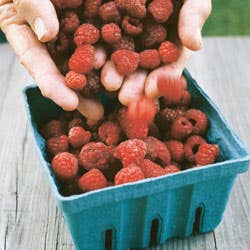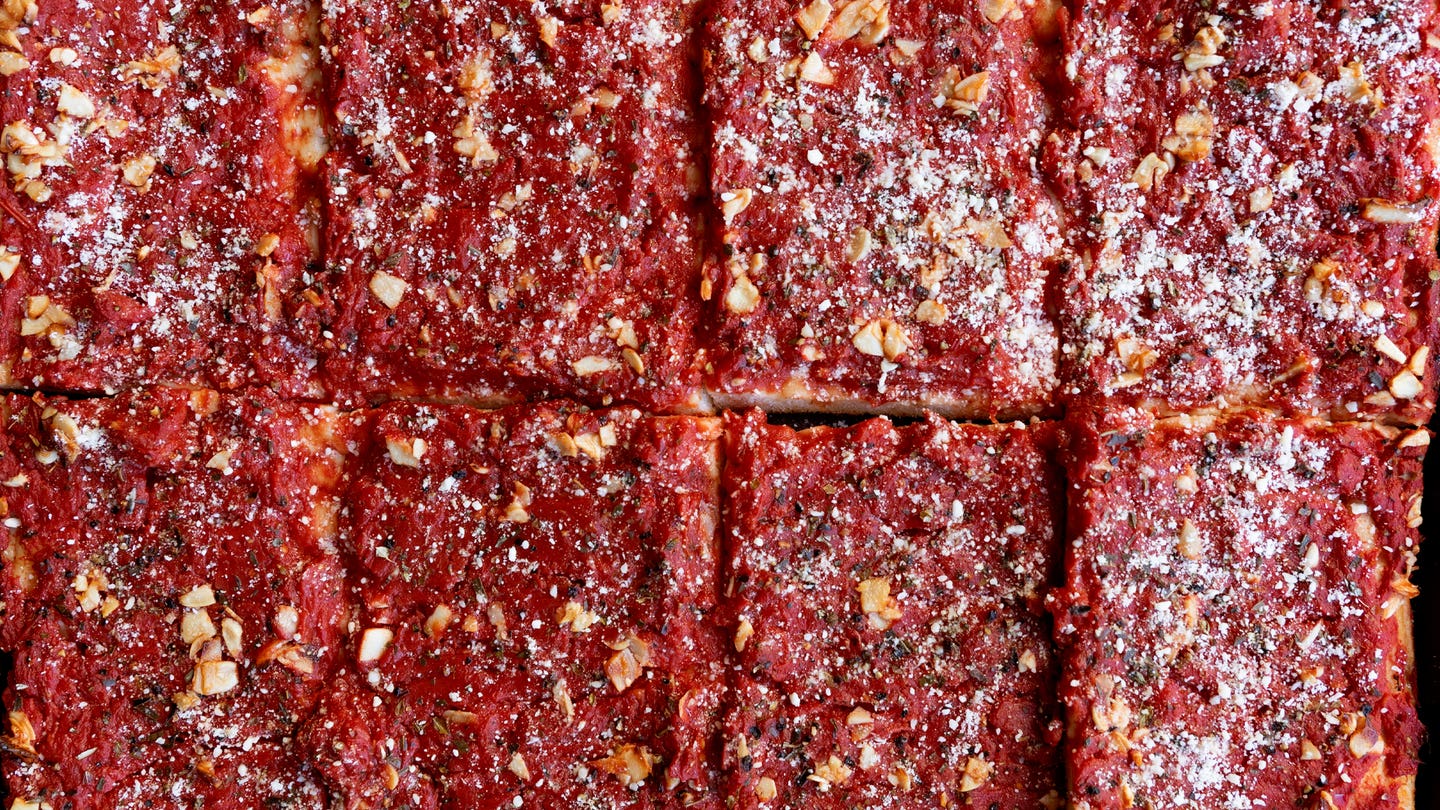
The Fruits of Summer
Nothing evokes the season as vividly as the soft, perfumed taste of perfectly ripe, juicy raspberries.
Our raspberry canes flower each spring, emerging green tipped from their winter's slumber. If my wife, Susan Morgan, and I were more diligent gardeners or lived year-round in our farmhouse, no doubt we'd be out among the canes in early April, wielding hand pruners and pulling weeds. But we're summer folk in the tiny upstate New York town of Mecklenburg, about ten miles west of Ithaca, and the raspberries were here when we bought the place back in the 1980s. And when they appear each year, they're like a gift, offering us the soft, perfumed taste of summer.
Over time, the patch we found here originally has grown, engulfing a gnarled mcintosh apple tree and spreading past the old chicken coop; it now covers a good 1,200 square feet of our backyard. Accordingly, when the berries are ripe we require that all members of the household, including guests, pick before dinner. When our two children, Ethan and Seneca, were small, we'd send them out together with a single quart-size box, and they'd disappear into the four-foot-high canes trailed by our golden retriever, Coffee Bean—who'd mouth-pick from the lower sprays, never contributing his finds. Now we all fend for ourselves. Besides eating the berries as we pick, we gather 40 to 50 quarts each summer to use in myriad ways—for shortcake and cobbler, on cereal, and quart after quart for the hungry jam pot. It's all part of our annual rhythm, which makes July in the Finger Lakes a season of remarkable, if fleeting, bounty.
Raspberries—once known as "raspisberries," perhaps because of their rough, rasping surface—are members of the rose family, found on every continent but Antarctica. There are countless varieties in North America, most of them deriving from two main species: Rubus idaeus, the red raspberry—though it can range in color from white to orange, pink to purple—apparently named by the Swedish botanist Linnaeus for Mount Ida in Greece because the berries flourished there; and Rubus occidentalis, the black raspberry, which is native to the eastern United States. These smaller, rounder berries, often called blackcaps, are renowned for their intense, bewitching flavor and are most commonly found growing wild in large patches from the Carolinas to New York. Cultivated blackcaps are almost impossible to find, though, in markets: Commercial growers shy away from them because they're susceptible to viruses. Incidentally, because blackcaps are usually black (though red and yellow forms do exist), they are easy to confuse with their cousin the blackberry. But there is an easy way to distinguish a blackberry from any raspberry: when one of the latter is picked, its tiny white receptacle stays on the vine, leaving a wee hole in one end of the berry.
In his seminal 1925 work The Small Fruits of New York, horticulturist U. P. Hedrick traces the history of the cultivated raspberry in the U.S. and England, noting that " … Rubus idaeus has received the attention of gardeners but a short time, and that its evolution has not gone far, especially as compared with that of the tree fruits." In fact, the first written account of raspberries as a garden plant in England doesn't occur until the mid-16th century, while in America there seems to be no mention of cultivated raspberries until 1771. Hedrick explains: "Wherever its culture could have succeeded the native plant runs riot in waste places. It is one of the first plants to follow forest fires, to creep into newly cleared lands, and becomes a weed in fence corners and neglected fields. Not until agriculture was well advanced, with little land in waste, could there have been a need for cultivated raspberries."
In my opinion, though, wild reds are more seed than flesh, and their flavor pales before that of modern cultivars. There are two main types of cultivated raspberries: summer-bearing and fall-bearing—also called everbearing, because, despite their name, they have the potential to produce both a summer and a fall crop. Our patch is everbearing, yielding fruit in early July and late September. But for the best output the immensely knowledgeable Dr. Marvin Pritts, professor of horticulture at nearby Cornell University, recommends a two-step program: growing summer-bearing varieties for July fruit and completely mowing down everbearing varieties in early spring so that they'll produce only a single, but larger, fall crop. According to Pritts, the Holy Grail for raspberry breeders is to develop both summer berries that will produce through late August and fall-bearing varieties that will ripen earlier, allowing the two growing seasons to merge. (They've almost succeeded.) You can see the appeal: over three months of fresh berries.
The bifurcated growing season is one of many reasons store-bought raspberries are so expensive. Another is the labor involved in handpicking the fruit. "Also," Pritts adds, "raspberries are so darn perishable." That's because they burn up sugar faster than any other fruit and begin to mold shortly after they are picked.
One summer, when our large, shabby patch was at its peak, Ethan and Seneca were away at camp, and the only people in the house were my wife, my parents, Sid and Dolly, and I. My father has lived in Brooklyn most of his life, and while there are many things he's never gotten used to about the countryside—including flying insects and our swimming pond—he loves picking berries. It gets him into the natural world like nothing else. For me, there's something so sweet about it. Maybe it's the quiet rhythm of working in a beautiful place with people I love, or maybe it's the promise of the jam making that follows. Susan and I have been making lots of raspberry and blackcap jam since we bought the house and are pretty proud of the results.
The reason our jam is so luscious is that it consists of nothing but berries, sugar, and a squeeze of lemon juice, which we've found helps keep the color bright. Using pectin in cooked jam (as opposed to freezer jam) makes about as much sense as adding pectin to maple sap to make syrup: it misses the point of the process, which is not to create thickness but to concentrate flavor. And for that there is no substitute for boiling.
By now, we've got our routine down. For a batch of raspberry jam, we never start with less than six quarts of berries. (For blackcap jam, my favorite, we'll work with four, because blackcaps are much harder to come by.) We dump the fruit into a big stainless-steel pot, then crush it by hand, running it through our fingers until the largest lumps are gone. This was once the kids' job, and I can still picture them covered in berry goop up to their elbows, grinning. Next I bring some water to a boil in a speckled enamel canning pot that I've hauled down from atop the cupboards, where it perches undisturbed for most of the year. Before long, the berry mixture is bubbling on the stove, while Mason jars, lids, and ring caps sterilize in the boiling water. We skim any foam off the jam and adjust the sugar and lemon juice to taste. Then there's nothing to do except stir and wait and enjoy the sweet scent that's filled our house.
When the last drops of a spoonful of the mixture begin to jell before falling back into the pot, it's time to start moving. Everything has led up to these frenzied moments, and we do our best to pour the jam into the jars without scalding ourselves or before it gets too cool. (If this happens, we bring it back to the boil.) What speed! What dexterity! What long years of happy practice!
We work fast, and soon, very soon, our blue kitchen counter is lined with the sparkling, jewel-like jars. It's a lovely sight: summer preserved, to be spread, on winter mornings, on toast until the canes come alive again and the bright berries glow against green leaves.
Keep Reading
Continue to Next Story










